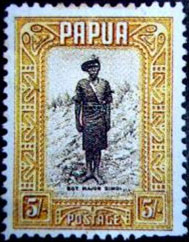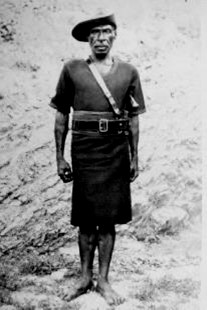Papua: The world’s first police on postage stamps: Maxwell Hayes
One of the world’s most popular collectables is postage stamps. There are, however, many more serious collectors who branch out into other aspects of philately, air mail covers, first day covers, various post office cancels, Antarctic covers, Olympic games issues, a particular country, POW mail, censorship covers, and many more diversified specialized interests.
In a field of its own there are thematic collectors, collecting such diverse subjects as butterflies, flowers, cars, trains, planes, uniforms, whales, boats and many other specific subjects. This is called “thematic” philately which includes not only postage stamps of the theme but also postally used covers, first day covers, pictorial cancels, slogan cancels, special cards, envelopes and so on.
As I was then a commissioned officer in the Royal Papua New Guinea Constabulary, it seemed to be appropriate to collect police on postage stamps. I became an early member of the German Police Philatelic Study Group, the Law Enforcement Study Group (USA) and the Constabulary and Other Philatelic Society, England (COPS). Through this society journal, I learned that the first postage stamp in the world ever to depict a police officer originated in Papua in 1932.
At the peak of my collection, I had a collection of over 600 pages of researched and written material.
I wrote about my collection in issues of Magazine of the Australian Section IPA, the predecessor to Police Down Under, in articles entitled “From A (Aden) to Y (Yemen)”. Unfortunately there was never a “Z”. These articles appeared in ten issues from February 1981 to August 1982 and were reprinted in two IPA annual handbooks.
The earliest items I managed to buy in auctions (at quite a high price) were postally used “entires” from the Arma dei Carabinieri of the various states of Italy in the early 1800s. An “entire” was a letter written on parchment, folded several times, sealed with wax, and then cancelled at the nearest centre with a steel striker with the town name. In the days before adhesive postage stamps which required pre-payment of the letter, the appropriate fee to be paid by the recipient was based on distance, weight and for the carriage of the letter, and was collected from the recipient. Naturally this system meant that many refused to accept the letter. A better system had to be found and in 1840, an English schoolmaster Rowland Hill (later Sir Rowland Hill, KCB, FRS) introduced the first postage stamp in the world, the pre-paid 1d (one penny) black stamp.
Papua New Guinea (in its various names) has always had a very close working relationship with its police through the exploratory and pioneering patrols, police inter-marriage between different tribal groups and the high standards displayed by members of the fiercely loyal native constabulary. It is, therefore, fitting that the first postage stamp in the world to depict a policeman originated in Papua.
 A 5/- olive brown and black stamp issued on 14 November 1932 depicted Sergeant Major Simoi, a native Papuan then of the Armed Native Constabulary (Papua) also variously known as the Armed Native Constabulary (ANC). Originally known as the British New Guinea Armed Constabulary (BNGAC) formed in 1890 by the Lieut. Governor, Sir William MacGregor, with the nucleus of 12 Fijian native police, it was intended to be eventually replaced with Papuans encouraged to join this fledgling force.
A 5/- olive brown and black stamp issued on 14 November 1932 depicted Sergeant Major Simoi, a native Papuan then of the Armed Native Constabulary (Papua) also variously known as the Armed Native Constabulary (ANC). Originally known as the British New Guinea Armed Constabulary (BNGAC) formed in 1890 by the Lieut. Governor, Sir William MacGregor, with the nucleus of 12 Fijian native police, it was intended to be eventually replaced with Papuans encouraged to join this fledgling force.
Simoi, the son of Gidau, was born c. 1877 at Katatai Village, Kiwai Island, at the mouth of the lengthy Fly River in the Western District. He joined the BNGAC in 1899 as a Constable on a pay scale of 10/- (ten shillings) with rations a month, followed the following year by a raise to £1.0.0 (one pound) p.m. In 1901 he was a Lance Corporal and soon promoted to Corporal. He took part in many interior expeditions in which he was wounded by arrows on many occasions amongst numerous headhunting and very primitive tribes and, showing outstanding courage, was quickly promoted to Sergeant, this then being the highest rank available for a Papuan.
In 1905, together with another Papuan Constable, he was commended for a remarkable feat of bravery in saving the life of the Administrator (Captain F.R. Barton), Judge Hubert Murray and other Europeans when their whaleboat capsized in treacherous heavy seas off Vailala in the Central Gulf of Papua.
At a time when Papuan wages on the outstations were extremely low, compared with higher wages in Port Moresby and environs, Simoi left the BNGAC and worked for some years as a native labour supervisor and recruiter in the Central District.
Following the foundation of the Commonwealth of Australia in 1901, the Papua Act of 1906 passed the transfer of British administration (though for all intents and purposes this had been carried out by the Colony of Queensland) to Australian rule and created the Territory of Papua. The constabulary was then renamed the ANC. In 1912, Simoi sought to return to the uniform on the ANC and was first Papuan promoted to the rank of Sergeant Major. He remained in the constabulary and, when on leave in his home village, developed pneumonia. He was brought to the nearest hospital at Daru, several days sailing distance, but died on 28 February 1934. He was buried at Katatai with full police (military style) honours. His death was reported in the Papuan newspaper, the Gazette, and other publications.
While still serving, such was his stature amongst Papuans, that for his loyal and long service to the constabulary, he was honoured by being depicted in full uniform with slouch hat, cane and Coat of Arms badges of rank on the 1932 stamp which is now exceedingly rare in mint form, and slightly less so in used or cancelled form as, in the 1930s depression era, 5/- was quite a considerable amount of money.
In my opinion there can be no justification for the issue of such high value stamps of 5/- (10/- and £1.0.0 in the same series) when it cost around 1d (one penny) for letter postage. Clearly these high value stamps were designed to create revenue at the expense of philatelists. Consequently not a great number of these high value stamps were issued and, being rated exceedingly rare to rare in much later years, commanded a very high price. Eventually I managed to obtain one of the Simoi stamps to add to my collection by mortgaging around a month’s salary.
Further information for this article comes from an article published on Simoi Gidau by James Griffith to whom I am indebted.




